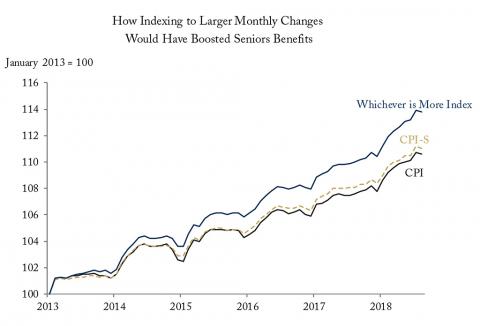From: William B. P. Robson
To: Filomena Tassi, federal Minister of Seniors
Date: June 27, 2019
Re: Seniors Consumer Price Index Follies
Your government’s 2015 election platform had a problematic plank. It promised to calculate a Seniors Price Index more reflective of things seniors consume than the current Consumer Price Index (CPI). It further promised to link seniors’ benefits to whichever of the new index or the CPI increased more in a given period.
This was a bad idea.
Even the concept of a Seniors Price Index is questionable. Because some prices always move relative to other prices, people often complain that the CPI doesn’t reflect reality for groups such as homeowners, rural residents, or seniors. But inflation is fundamentally about money losing its value – something felt equally throughout the economy.
The second part of the plank – to link benefits to whichever index rises more – is utterly arbitrary and unfair. Because relative prices always move, linking transfers to whichever index happens to rise more in a given month, quarter or year will ratchet up the real value of those benefits – even if the longer-term trend in the two measures is identical.
Last week, Statistics Canada released a Consumer Price Index for Seniors (CPI-S) at the request of Employment and Social Development Canada – presumably a first step toward fulfilling the election promise. Now we have actual numbers to help judge the relevance of this index, and the wisdom, or not, of the heads-I-win/tails-you-lose approach.
Data challenges stopped Statistics Canada calculating the CPI-S earlier than January 2013, and obliged them to use less current spending numbers than for the CPI itself. So we have only a short period – January 2013 to August 2018 – and a potential upward bias in CPI-S relative to the CPI. Over that period, the CPI-S increased at an annual rate of 1.89 percent – below the Bank of Canada’s 2-percent target, and a scant 0.07 percent more than the increase in the CPI. (Because consumers substitute cheaper for more expensive items when prices change, indexes weighted by base-period spending have an upward “substitution bias.” Statistics Canada warns that its CPI-S may have a worse substitution bias than the CPI.)
But overall, Statistics Canada concluded: “The two indexes showed very little difference in trends, which may imply that the sub-population of seniors and the overall Canadian population are facing the same general inflation.”
If we can fix any bias in the CPI-S, you might think that even if there’s little value in a special index for seniors, there’s also little harm. Last week’s numbers show why this is wrong.
Suppose we had linked seniors’ benefits each month from January 2013 to August 2018 to whichever of the CPI-S or the CPI rose more. They would have escalated at an annual rate of 2.34 percent – above the Bank’s target and 0.52 percent more than the CPI (see figure). Fulfilling the election promise might not involve monthly indexation, but the point is valid for any period: a benefit linked to whichever index rose more will rise in real value, advantaging recipients at the expense of everybody else.
Such favourable, and non-transparent, treatment for any group – rural residents, homeowners, or seniors – is neither sensible nor fair. The government can do better things to help current and future seniors save on necessities and live better in retirement. Statistics Canada has made a first step toward a Seniors Price Index. That step should be your government’s last.
William B.P. Robson is President and CEO of the C.D. Howe Institute.
To send a comment or leave feedback, email us at blog@cdhowe.org.
The views expressed here are those of the author. The C.D. Howe Institute does not take corporate positions on policy matters.






